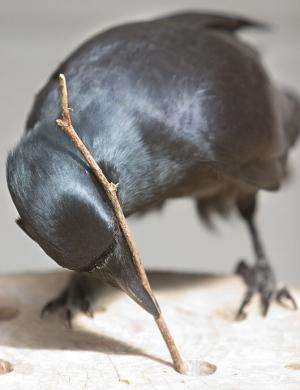Canny crows know their tools

(Phys.org) —Scientists at the University of St Andrews have discovered that New Caledonian crows, famous for their use of tools to extract hidden food, do not rely on guesswork when deploying one of their most complicated tool types; hooked stick tools. In fact, research published today suggests that they pay close attention to the features of each tool, ensuring that the hooked end is oriented correctly for snagging prey.
Dr Christian Rutz, team leader and co-author of the study, explained that "only two species are known to make hooks in nature – humans and New Caledonian crows. Hooked tools have clear functional polarity, and we were interested to see how crows avoid using their tools in the wrong orientation."
The study investigated hooked stick tools, which wild crows manufacture by using their bills to snip a forked stick out of a shrub. This stick is then 'crafted' by the careful removal of wood and bark, leaving a curved twig with a neat hook at the end. The crows use these tools to extract prey items such as insects from their hiding places in holes and crevices.
The researchers found that wild-caught crows consistently used replicas of these tools in the correct orientation, even when they were experimentally provided upside-down. This finding contrasts with earlier research by a different team, in which crows used trial-and-error to work out the correct orientation of a different type of hooked tool. Together, these studies suggest that crows are capable of observing tool features and using the information appropriately, but – like people – they sometimes try to take short-cuts.
The St Andrews team delved a little deeper into the decision-making process, by providing crows with a series of 'trick' tools, each of which had one feature (such as a hook) at one end, and another feature (such as curvature) at the other. Dr James St Clair, the lead author of the study, explained: "By recording which end of each tool the crows used to extract food, we were able to find out which particular features they considered most – and least – important."
Of three tool features investigated, the hook was most important to crows deciding how to orient their tools, despite being the most subtle to human eyes. Although the relative importance of each of these features is unknown, it seems likely that the hook contributes the most to foraging success, suggesting that the crows' decisions are geared towards the best possible outcome – and are thus ultimately adaptive.
Despite the striking results of the study, Dr St Clair cautions that "We still can't say whether New Caledonian crows actually 'understand' how their tools function. But of course, this is also true of many humans I know!"
The article will be published as part of a special issue of Philosophical Transactions of the Royal Society B and is titled 'New Caledonian crows attend to multiple functional properties of complex tools.'
Journal information: Philosophical Transactions of the Royal Society B
Provided by University of St Andrews





















